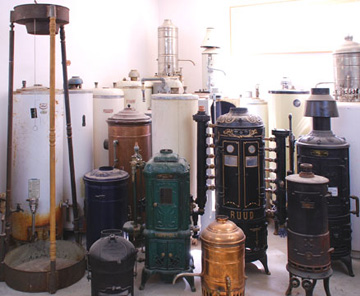Most water heaters sit silently in a dark corner of the basement, all but forgotten until the day cold water comes streaming out of the shower. Suddenly, it’s a water heater emergency!
 When forced to confront the dizzying array of types and options, it is easy to default to simple replacement: like for like. We need hot water, so just put one in… the water heater is often viewed as an appliance rather than an integral component to the home.
When forced to confront the dizzying array of types and options, it is easy to default to simple replacement: like for like. We need hot water, so just put one in… the water heater is often viewed as an appliance rather than an integral component to the home.
Of course, as with most components of the home’s building systems, the water heater is integrated into a complex web of interaction – in addition to the plumbing system, it also interacts with the heating/cooling, electrical, and ventilation. It can certainly impact the home’s energy efficiency, but also the overall climate and health of the home.
Plumbing System
As an integral part to the home’s plumbing system, the water heater’s main responsibility is providing hot water for use at showers and sinks. Usually, there is a single pipe that moves the water from the water heater to the use. When you turn on the tap, that pipe is filled with cold water which runs out the faucet and down the drain. You wait until the water is hot and then use it. Depending on the distance between the faucet and the water heater, this can result in gallons of wasted water every day. The energy used to heat that water goes right down the drain.
When we are planning new homes, we will often try to group water fixtures together and minimize the distance between the water heater and the fixtures to reduce this loss. Another strategy we employ to reduce energy loss is to insulate pipes. In more complex projects, hot water pipes will be installed in an insulated “loop” that cycles hot water continuously so it is always available at the point of use.
Replacing a water is often a good time to look at adding pipe insulation or relocating it to a spot closer to where hot water is needed.
Type
The type of water heater installed can also have a big impact on the home. More and more, “power vent” water heaters are selected – they transfer a much higher percentage of the heat from the gas burner to the water, which results in a lower exhaust temperature. This exhaust can be vented out the side of the home through PVC piping rather than up through a flue or chimney.
Electric water heaters are also becoming a more efficient option. Though electricity is overall a less efficient method of creating heat than gas, hyper-insulated models are available that allow the unit to be more efficient about its work. Another benefit of all-electric appliances is the air quality in the home. There is no need to worry about carbon monoxide with an electric appliance. There are also fewer parts to monitor.
Point-of-use or on-demand water heaters are often considered as an option due to their ability to produce never-ending hot water. This may seem like a great benefit at first, but there are some drawbacks to this type. First, they will tend to necessitate upgrading electrical and/or venting – they use a lot of energy “on call” and need to have adequate supply. The colder the water is coming in to the unit, the more immediate energy it will take to heat it to temperature. They are also more complex and will require more maintenance than a more traditional tank unit. Unless there is a specific need for a tankless water heater, it is usually recommended to upgrade tank size and insulation rather than convert to an on-demand system.
Newer options include the technically advanced hybrid heat-pump, which has the ability to pull heat from the air around the unit and transfer it to the water. While this is an efficient electric model, it can also create a higher heat load for the furnace during the winter months because it is in essence taking the heat from the house and using it to raise the temperature of the water. If it is located correctly, this issue becomes less of a problem.
Big Picture
Changing the type or location of a water heater can impact multiple systems – they have different water supply, power, and venting requirements that need to be met. Over the long term, it is recommended that homeowners include the water heater in their long-term strategies for increasing energy efficiency in their homes.